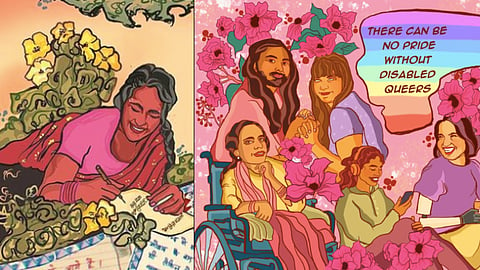
- HOMEGROWN WORLD
- #HGCREATORS
- #HGEXPLORE
- #HGVOICES
- #HGSHOP
- CAREERS
- ABOUT US
- CONTACT US

“When I see a queer or disabled character on screen, it can either be too caricaturish or too realistic. If it's too realistic, it can be triggering and I can't enjoy it. It will take me a long time to finish the show or movie.”
Ritika Gupta (she/her)
Quinni from Heartbreak High finds it really hard to focus in loud spaces. This often makes her friends think that she’s ignoring them. A queer, autistic girl being one of the main characters in a Netflix show captured some of the experiences that Ritika Gupta never had the vocabulary to articulate. But this is an Australian high school drama that couldn’t possibly hope to emulate the cultural nuances of growing up in Gaya, Bihar.
Asexual, neurodivergent, and pan-romantic visual artist Ritika began pouring out the rage she felt — of being stuck in a town where no one understood queerness — into belligerent, Fauvist-like acrylic scenes on canvas. This was the first year of the pandemic in 2020 and though the real world lacked the means to make sense of her intersectionality, she found a strong communion with BTS and K-pop fans online. The internet is where queer people and those living with disability become politically conscious, exchange information and help each other cope with the hostility they perceive from the world at large.
“As an autistic and disabled queer person, I find myself in search of a different community because I don't fit in either the disabled or the queer communities,” says Ritika.
Queer people and those living with disabilities share similar inequities: Both have been scrutinised by medicine; antagonised by religion; have had to fight for their place in housing, employment, and education; pigeonholed in representation; targeted by haters on the internet; and isolated socially, often in their own families or communities.
“Revival Disability India was the first community I got to know online. I started talking to their members on a Whatsapp group, whose experiences were multifaceted but they understood what I was going through.”
A defiant child of the pandemic, Revival Disability India germinated from a digital magazine to flourish into an inclusive platform where disabled and intersectional voices can co-mingle and surmount the travails of an ableist, cis-normative society together.
Roughly 26.8 million Indians live with one or more disabilities — and how many of them are queer is difficult to quantify due to lack of statistics — according to a 2021 report by the Ministry of Social Justice and Empowerment. Going off of these numbers, there’s no excusing the continued invisibility of persons with disabilities in LGBTQ+ spaces.
For queer people living with disabilities — who often need to be aware of their disabilities and to take it in their stride while also maintaining relevance within the queer community — Ritika maintains that pride parades and other large-scale events can sometimes seem inaccessible and socially exclusionary.
“I feel like online spaces give me more freedom to express myself and to take my time to form friendships more organically. Because of how offline queer events are designed, most of my energy goes into navigating these spaces and figuring out how to exist in them. It’s too chaotic with everyone taking selfies and I can’t seem to connect to people.”
Ritika also found more friends among people who messaged her directly on her Instagram art page, lauding her for making relatable and meaningful illustrations.
Following her autism diagnosis, Ritika’s art slowly began to change in terms of the color palette. The vibrant pinks and lavenders she daubed her childhood memories with began to make a comeback. Moreover, she began to see art as not just an outlet but as a statement, an instrument for control and a crack in the armour from where light and joy could trickle in.
“My art is influenced by my day-to-day life, my relationship to myself and all that happens to me. It’s been influenced by queer movies I have seen, the books I resonated with, and the lyrics that stuck to me. I’d make a note of these and then lay in bed at night, running them over in my mind; storyboarding my experiences.”
As prolific as she is, allowing herself to rest is a luxury that Ritika has learnt to normalise. Her autistic, queer community kept reminding her to take it easy and not overwork herself.
“Not many organisations or employers will accommodate you and give you the time you need. I was always afraid that if I let go of an opportunity, then I won’t get more work again. But you have to listen to your mind and your body.”
The color of our skin, how our minds or bodies work, the abilities we are born with and myriad other vapours are all distilled into the crucible of the identities that make us individuals. We can’t disentangle ourselves from these elements but we can draw strength from them like Ritika to make our voices truly unique and authentic.
Ritika Gupta is a freelance illustrator whose digital art examines themes like neuroqueerness, disabled rest, accessibility and inclusiveness.
You can find more of her visual art here.
If you appreciated this piece, then here's more from Homegrown:
Virali Modi's Modelling Explores The Intersection Between Self Expression & Disability
Parth Pawar's Art Is A Psychedelic Intersection Of Queer & Genderfluid Identity
How To Be Muslim & Queer: An Inclusive Space Normalising Intersectional Identities
